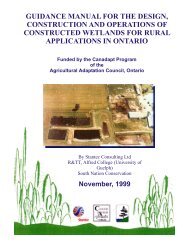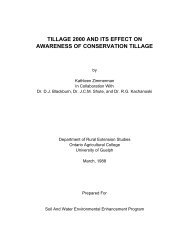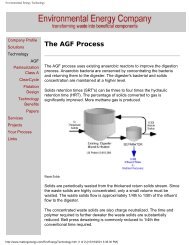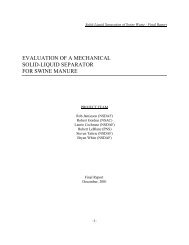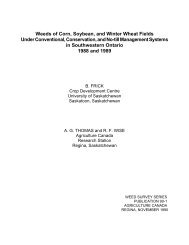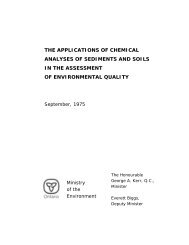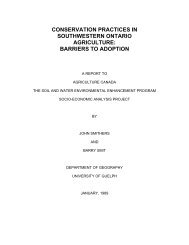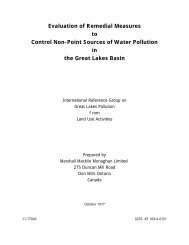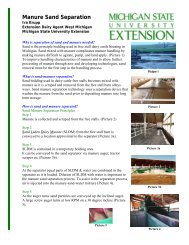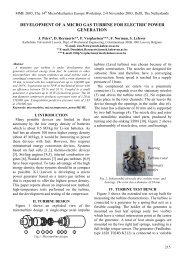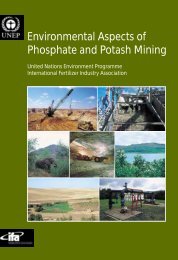Physical Characteristics and Land Uses of the Avon River Drainage ...
Physical Characteristics and Land Uses of the Avon River Drainage ...
Physical Characteristics and Land Uses of the Avon River Drainage ...
- No tags were found...
You also want an ePaper? Increase the reach of your titles
YUMPU automatically turns print PDFs into web optimized ePapers that Google loves.
associated with a former glacial spillway. Valley walls rise as much as 15 meters (50 ft.)to <strong>the</strong> surrounding till plain, <strong>and</strong> <strong>the</strong> valley itself is generally less than 300 meters (980 ft.)across.Surficial deposits <strong>of</strong> <strong>the</strong> sub-basin west <strong>of</strong> station 1 consist largely <strong>of</strong> Stratford s<strong>and</strong>y silttill interspersed with large pockets <strong>of</strong> lacustrine silt <strong>and</strong> clay. Deposits <strong>of</strong> alluvial <strong>and</strong>outwash gravel, s<strong>and</strong> <strong>and</strong> silt occur along <strong>the</strong> river. Overburden thickness ranges from 15(50 ft.) to 52m (170 ft.) .In <strong>the</strong> upper basin above station 1, overburden thickness is greater, ranging from 37 (120ft.) to 64m (210 ft.). Surficial geology is more complex with areas <strong>of</strong> silty to s<strong>and</strong>y till,Kame s<strong>and</strong> <strong>and</strong> Lacustrine silt <strong>and</strong> clay. Alluvial deposits occur along <strong>the</strong> main drains in <strong>the</strong>area, <strong>and</strong> <strong>the</strong>re are local pockets <strong>of</strong> peat, muck <strong>and</strong> marl.Silt loam soils predominate in <strong>the</strong> <strong>Avon</strong> basin. These are found especially on <strong>the</strong> flatterareas <strong>of</strong> <strong>the</strong> lower <strong>and</strong> upper basins. S<strong>and</strong>y loams are found to <strong>the</strong> east in <strong>the</strong> moraineareas while to <strong>the</strong> west <strong>the</strong>re are some clay loams. Small areas <strong>of</strong> muck <strong>and</strong> bottom l<strong>and</strong>run along <strong>the</strong> main channel. Table 1 gives details <strong>of</strong> <strong>the</strong>se soil types.In general, <strong>the</strong>se soils are imperfectly to poorly drained, with only 20% <strong>of</strong> <strong>the</strong> watershedconsidered well drained. As would be expected, <strong>the</strong>se well drained areas are found largelyin <strong>the</strong> eastern end <strong>of</strong> <strong>the</strong> basin.Agricultural capabilities <strong>of</strong> <strong>the</strong>se soils are quite high. Class 1 l<strong>and</strong> comprises 60% <strong>of</strong> bothDownie <strong>and</strong> North Easthope Townships <strong>and</strong> 50% <strong>of</strong> Ellice Township. About one quarter <strong>of</strong><strong>the</strong>se soils are in Class 2W, which indicates excessive moisture (Table 2).6



